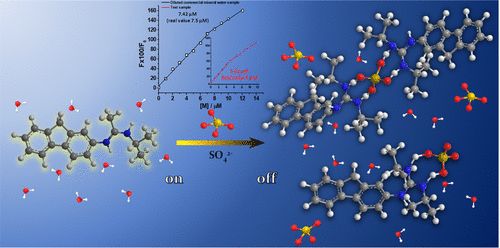Our official English website, www.x-mol.net, welcomes your
feedback! (Note: you will need to create a separate account there.)
Novel Fluorescence Guanidine Molecules for Selective Sulfate Anion Detection in Water Complex Samples over a Wide pH Range
ACS Sensors ( IF 8.2 ) Pub Date : 2021-08-31 , DOI: 10.1021/acssensors.1c00876 Pedro J Pacheco-Liñán 1 , Carlos Alonso-Moreno 2, 3 , Fernando Carrillo-Hermosilla 4 , Andrés Garzón-Ruiz 1 , Cristina Martín 1, 3 , Carla Sáez 1, 3 , José Albaladejo 5 , Iván Bravo 1, 3
ACS Sensors ( IF 8.2 ) Pub Date : 2021-08-31 , DOI: 10.1021/acssensors.1c00876 Pedro J Pacheco-Liñán 1 , Carlos Alonso-Moreno 2, 3 , Fernando Carrillo-Hermosilla 4 , Andrés Garzón-Ruiz 1 , Cristina Martín 1, 3 , Carla Sáez 1, 3 , José Albaladejo 5 , Iván Bravo 1, 3
Affiliation

|
Quantitative analysis of sulfate anions in water still remains an important challenge for the society. Among all the methodologies, the most successful one is based on optical supramolecular receptors because the presence of small concentrations of sulfate anion modifies the photophysical properties of the receptor. In this case, fluorescence anion sensors have been designed by the incorporation of guanidine motifs into fluorenyl cores. The photophysical behaviors of the new mono- (M) and bis-guanidine (B) derivatives were studied through pH dependence, solvent effects, and ion sensing on steady-state spectra and time-resolved fluorescence spectroscopy. In more detail, the results demonstrate that M is a highly selective and sensitive sulfate ion receptor in real water samples and, even more importantly, its function remains unchanged at different ranges of pH. The reason behind this resides on the fluorescence quenching produced by an internal charge-transfer process when the sulfate anion is complexed with M. It is worth noting that the global and partial affinity constants (1010 M–2 and 105 M–1, respectively) of complex formation are far above from the current sulfate sensors in water (104 M–1) which give an LOD of 0.10 μM in water with an analytical range of 2.5–10 μM. On the other hand, although it would seem, at first sight, that the B derivate will be the most promising one, the possibility of having two simultaneous protonation states reduces the complex formation and, therefore, its sensitivity to sulfate anions. The results presented here offer the possibility of using a new molecule in water environments, which opens the door to infinite applications such as the detection of trace amounts of sulfate ions in food or water.
中文翻译:

用于在宽 pH 范围内选择性检测复杂水样品中硫酸根阴离子的新型荧光胍分子
水中硫酸根阴离子的定量分析仍然是社会面临的重要挑战。在所有方法中,最成功的方法是基于光学超分子受体,因为小浓度硫酸根阴离子的存在会改变受体的光物理特性。在这种情况下,荧光阴离子传感器是通过将胍基序结合到芴核中来设计的。通过 pH 依赖性、溶剂效应和离子传感对稳态光谱和时间分辨荧光光谱,研究了新的单 ( M ) 和双胍 ( B ) 衍生物的光物理行为。更详细地,结果表明M在真实水样中是一种高度选择性和灵敏的硫酸根离子受体,更重要的是,它的功能在不同的 pH 范围内保持不变。这背后的原因在于当硫酸根阴离子与M复合时由内部电荷转移过程产生的荧光猝灭。值得注意的是,复合物形成的全局和部分亲和力常数(分别为 10 10 M –2和 10 5 M –1)远高于当前水中的硫酸盐传感器(10 4 M –1),后者给出了 LOD在水中 0.10 μM,分析范围为 2.5–10 μM。另一方面,虽然乍一看似乎B衍生物将是最有希望的一种,同时具有两个质子化状态的可能性减少了复合物的形成,因此减少了它对硫酸根阴离子的敏感性。这里展示的结果提供了在水环境中使用新分子的可能性,这为无限应用打开了大门,例如检测食物或水中的痕量硫酸根离子。
更新日期:2021-09-24
中文翻译:

用于在宽 pH 范围内选择性检测复杂水样品中硫酸根阴离子的新型荧光胍分子
水中硫酸根阴离子的定量分析仍然是社会面临的重要挑战。在所有方法中,最成功的方法是基于光学超分子受体,因为小浓度硫酸根阴离子的存在会改变受体的光物理特性。在这种情况下,荧光阴离子传感器是通过将胍基序结合到芴核中来设计的。通过 pH 依赖性、溶剂效应和离子传感对稳态光谱和时间分辨荧光光谱,研究了新的单 ( M ) 和双胍 ( B ) 衍生物的光物理行为。更详细地,结果表明M在真实水样中是一种高度选择性和灵敏的硫酸根离子受体,更重要的是,它的功能在不同的 pH 范围内保持不变。这背后的原因在于当硫酸根阴离子与M复合时由内部电荷转移过程产生的荧光猝灭。值得注意的是,复合物形成的全局和部分亲和力常数(分别为 10 10 M –2和 10 5 M –1)远高于当前水中的硫酸盐传感器(10 4 M –1),后者给出了 LOD在水中 0.10 μM,分析范围为 2.5–10 μM。另一方面,虽然乍一看似乎B衍生物将是最有希望的一种,同时具有两个质子化状态的可能性减少了复合物的形成,因此减少了它对硫酸根阴离子的敏感性。这里展示的结果提供了在水环境中使用新分子的可能性,这为无限应用打开了大门,例如检测食物或水中的痕量硫酸根离子。











































 京公网安备 11010802027423号
京公网安备 11010802027423号